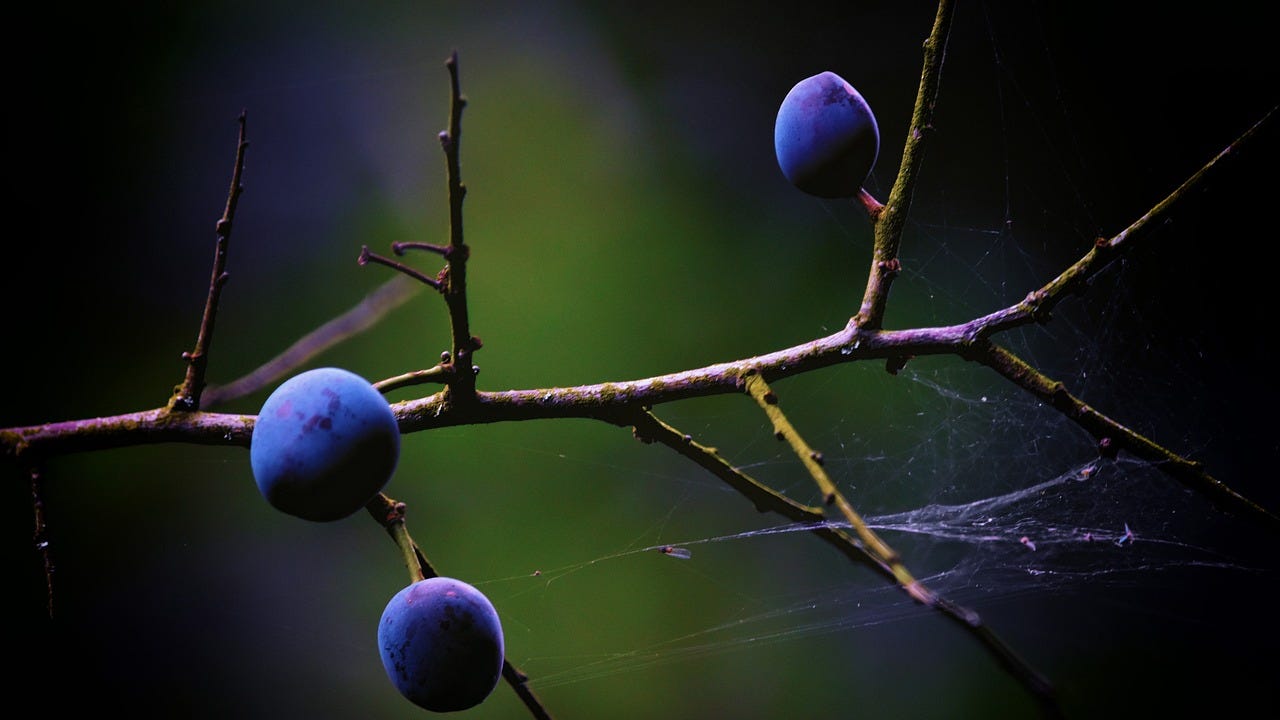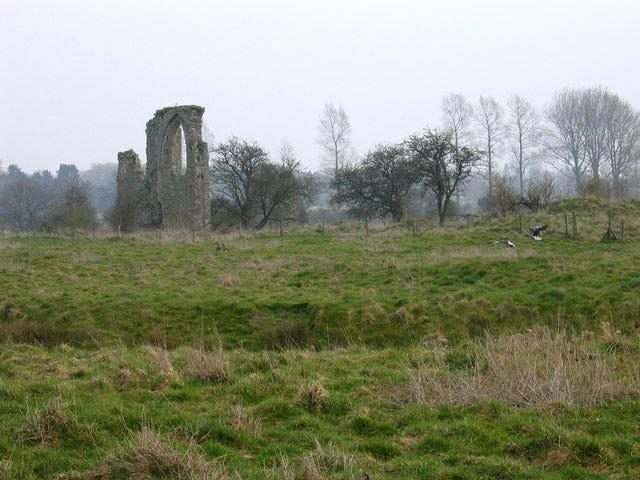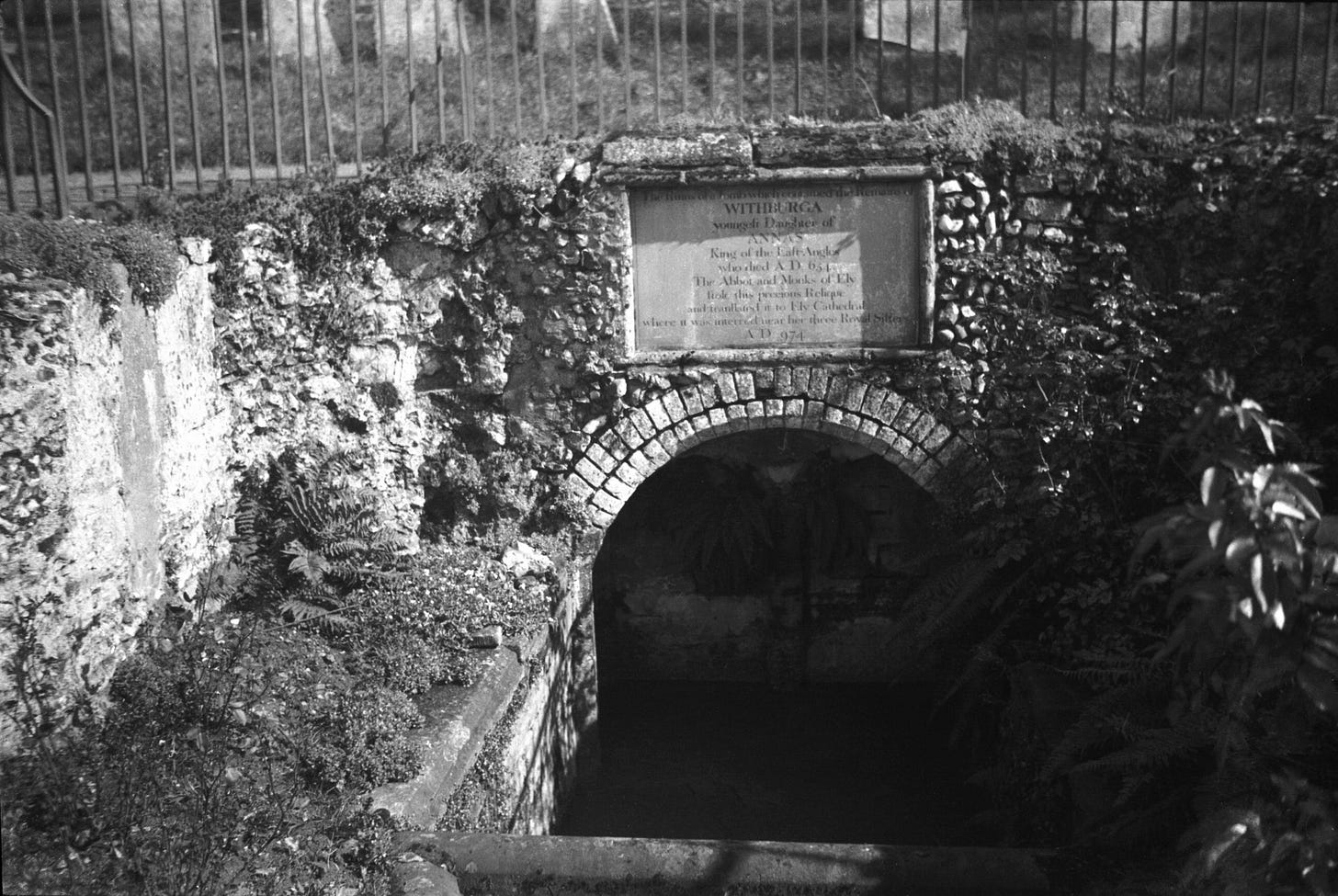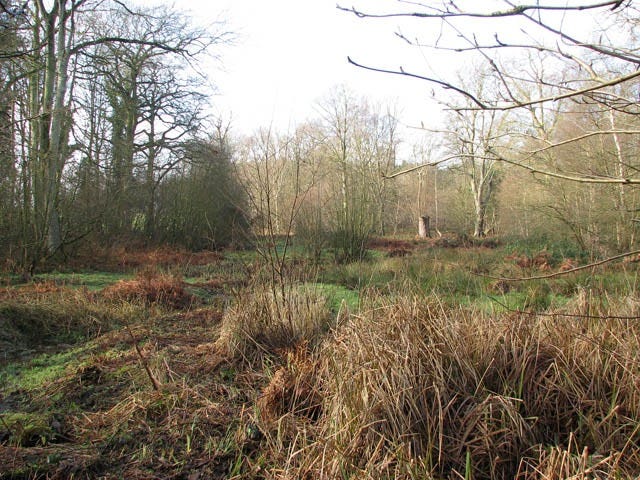A letter from Ada
My Most Esteemed and Thoughtful Readers,
As the veil of All Hallows’ Eve now flutters back into shadow, I find myself once again addressing you from the depths of autumn—November, that sombre month of mists and memory.
Gone are the garish frivolities of Halloween, replaced by something altogether more profound, more secretive. It is as though the earth itself now exhales, weary of the year that grows ever colder, its breath heavy with the weight of forgotten souls. How I love it.
This is a time when the living—though so fond of their comforts—cannot help but be drawn toward the mysteries of death and the afterlife, if only in fleeting glances. For November is not merely a passage toward the darkness of winter but a month rich with the morbid whispers of tradition.
As the days grow shorter and shadows stretch long, festivals such as Martinmas and All Souls’ Day remind us of our impermanence, echoing the rituals of remembrance in every quiet village and forlorn cemetery.
In the issue of Shuckstack before you, we explore, briefly, the folklore of the blackthorn—ominous and fascinating, with its delicate blossoms blooming only after its cruel thorns have pierced the wind. From its fruit, we draw sloe gin and port—concoctions whose warmth defies the chill of the encroaching frost. Dear reader, they are fit to warm even the iciest of spirits, should you care to indulge. Drink responsibly, might I add, by which I mean heavily.
As a girl, I recall how we adored the November displays of light and fire, though with far more pomp and trepidation than your modern explosive spectacles. How quaint to think that, in our time, the fiery celebrations of November 5th, while boisterous, were often a reminder of fire’s destructive power—of the fragility of homes, lives, and the very boundaries between the living and the dead.
You will also read the tale of the spirit said to haunt the well at Coxford. A tale I shall say little of here, for the true horror lies within the details. But suffice to say, this forlorn entity lingers at the water’s edge, bound to it by a tragedy long forgotten by most—though not by the well itself. Water remembers, friends, it is humans that forget.
In this edition of Shuckstack, we also have news of our Shuck Zine—its latest edition is now ready to grace your hands. Inside its pages, as ever, you will find tales of the strange, the unusual, and the wonderfully macabre. And, of course, it would be remiss of me not to mention another destination for the curious wanderer.
But alas, I must away, for November is a month best spent in reflection, with one’s thoughts drifting as gently as the last of the autumn leaves. Do enjoy these colder days, wrapped in your shawls by the hearth, as you sip your sloe gin and read our humble offerings. However: though you may find comfort in warmth and revelry, the darker forces that govern this season are never far away, watching you from the shadows as the year wanes. I am amongst them.
Ever yours,
Ada.
A new edition of Shuck
From the whispers of history and the shadows of time, we bring you Shuck 7: Witches. And what a magnificent collection of treasures it is – learn about witch bottles and witch stones, the very last witch trial in Norfolk (held during World War 2), the Kittywitches of Great Yarmouth and how to make your own witch cake. A warning: the witch cake will require the collection of urine.
There are stories of farmers and witches, a witch’s curse that cast a shadow over a Norfolk village for centuries and see the Witch of East Somerton (we know her name but will not share).
Then we have a map of Norfolk witches, a spell to bring magic to you and your home, we learn of Norfolk’s male witches and follow the county’s first witch trial where two ‘hill hunters’ were accused of enchantment. Then there are familiars, Toadmen, your own paper doll witch and our cover story, that of Monica English, Norfolk’s High Priestess of the Grey Goose Feather Coven who practised until only a few decades ago. Let us welcome you in:
Shuck’s latest creation awaits you here: https://www.etsy.com/uk/shop/SHUCKzine
Blackthorn: potent for the protected and ominous for the wicked
The blackthorn sets out its store for all to see: its petticoat of white blossom may be beautiful but beneath the froth hide spikes that repel those that wish it harm.
A tree with the power to protect against wrongdoing, create impenetrable boundaries, inflict strife on those that deserve it, in folklore blackthorn is the sister to hawthorn, both trees reflecting the light and dark seasons of the year.
A Blackthorn Winter in England is a spell of unseasonably cold weather in early April which often coincides with the blossoming of blackthorn, the pure white blossoms matching the snow or hoar frost in the fields.
It is said that blackthorn crosses the barrier between this world and that of the spirits or fairies and that meditating under the tree will allow you to talk to both – ensure you have an amulet with you to ensure you can make your way back to our realm.
Many superstitions are stitched into the history of the blackthorn: it is a tree that can heal and harm, one that is used in exorcisms and to dispel negativity.
The blackthorn thickets of Anglesey were so strong that they were said to have repelled a Roman invasion, ensuring it remained a Druidic stronghold. When self-proclaimed witch Major Thomas Weir was burnt alive in 1670 - declaring “I have lived as a beast and I must die as a beast!” – his blackthorn stick, which he claimed to use for his dark arts burned alongside him.
And as recently as 1940, poet Robert Graves discovered that people in rural Devon still feared those carrying blackthorn walking sticks, believing they were used by village witches.
This link with witchcraft is woven with superstition – people believed the wickedly sharp thorns were used to jab flesh and that they were tipped with poison to bring death to those whose skin was pierced.
Ada would like to remind us all that just as night falls, the sun rises and that Blackthorn is a beautiful tree with far more positivity within it than negativity.
Its plump black berries, or sloes, make for one of her favourite winter drinks (do not wait until the first frost to gather your sloes, make your own frost in your new-fangled ice box) and when the sticky sloes are strained from their slumber in gin they can be eaten on puddings and fancies.
Their juice, it is said, soothes inflammations in the mouth, as good a reason to take gin regularly as any, Ada believes, and equally as good a reason to be thankful for the much- maligned blackthorn.
How to make Sloe Gin and Sloe Port
Ingredients:
Enough ripe sloes to half-fill the jar you will be steeping them in
Golden caster sugar
1 litre bottle gin (you could also use rum, vodka, whiskey or even tequila!)
1) Pick your sloes – you can tell if they’re ripe enough by seeing if you can easily pop the berries between finger and thumb.
2) There’s a debate over what to do next. Some prick each sloe before placing in their two litre Kilner Jar, others prefer the lazier option of freezing the sloes overnight. Both practices emulate the first frost and split the skin on the berries. At this stage you can add a vanilla pod if you’d like sloe and vanilla gin.
3) There’s also debate about how much sugar to use. I’d cover the berries but Jamie Oliver only says you need “two big spoonful’s”. Hmm.
4) Add the gin to the top of the jar and seal. Shake. Every day for a week, shake the jar again and keep going until the sugar has fully dissolved. Then place in a cool, dark place and leave Christmas, although the longer you can leave it, the better. I’ve still got some of my 2015 vintage…
5) When you bottle, line a plastic sieve with muslin, set over a bowl and strain.
Sloe Port
When you’ve drained your sloe gin, don’t discard the berries, re-use them and make your own port! Technically it’s fortified wine, but let’s not split hairs. You’ll need the same jar you made your sloe gin in.
Ingredients:
About 500g sloes left over from sloe gin
750ml of red wine
About 100g sugar
200ml brandy
1) Add the sloes, sugar and wine to your container. Seal and shake daily for six to eight weeks, keeping it in a cool, dark place. Taste and adjust sugar if you think necessary.
2) Strain as above with sloe gin. Add the brandy and mix well.
The Spirit of the Well in Coxford
In quiet fields close to the wonderfully named River Tat in West Norfolk it is hard to imagine that a terrible murder once took place, a woman left to drown in a deep well. It is said that Lady Bone Well, also known as Mary Bone’s Well and Marie le Bonne Well, is named for the woman who tragically died there: at the hands of a local priest.
This ancient well can be found – or could be found, it may now be lost to the marshes and to time – close to the remains of the St Augustinian St Mary’s Priory, between Coxford and Broomsthorpe. St Mary’s was founded in the 12th century and became one of the wealthiest Augustinian houses in Norfolk before the Reformation in the 1530s.
Ruins of the priory remain, including sections of the priory church and earthworks of the rest of the buildings, while the precinct and fish ponds can be seen from the air.
At this site a Roman coin hoard was discovered in the 18th century and a gold medieval finger ring thought to have belonged to lawyer Thomas Gawdy, a well-known member of the Norfolk gentry in the 16th century. Three-day annual fairs were held here in honour of St Thomas of Canterbury and another annual fair marked the feast of St Barnabus. The priory was dogged by scandal.
When Archbishop Peckham visited the priory in January 1281, he found – according to British History Online – “…so lax a state of discipline that he subsequently sent the prior a long letter, in which he says that he had found him lacking in religious zeal, not attending divine service regularly, and failing to control his subordinates, so that by his negligence the canons go out coursing with hounds, attend banquets, chat with girls, and bring the house into contempt, causing it to be a scandal and a jest to the neighbourhood.
“Those who were suspected of incontinency were not to be allowed outside the priory except in cases of necessity, and then only when accompanied by others of good fame, and if they spoke to women or went into their houses they were to be severely punished; nor were women to be admitted to the priory on any account, save in the case of great and noble ladies accompanied by their trains who could not be refused.”
In 1514, Bishop Nicke paid a visit and found that “…the brethren were disobedient, quarrelsome, and incorrigible…” and that the Canon had run away four times before being imprisoned.
As the lady of the well’s legend says that she was “a woman of the priory” it could possibly mean that she was associated to the Augustinian house before 1281, when women were banned.
But it appears those who worshipped – or at least should have worshipped – at the priory held little regard for rules from on high, leading to speculation as to what happened to the poor woman in question.
One thing, however, is for certain: the water from the well in question was the main supply to the priory, meaning that if it was the site of a murder, it was one that literally tainted all who drank from its depths.
In 1619 Sir Roger Townshend and his master mason, William Edge, used materials from the old priory to build Raynham Hall and it was said by Spelman in his History of Sacrilege that this was the reason why that building collapsed! The present Hall was started in 1622.
Norfolk has a wealth of ancient wells, many of which are said to have magical powers. At Ashill, two timber-lined well shafts were found in 1874 during railway excavations thought to be more than 2,000 years old.
There were signs that the Ashill wells had been used for magical rituals as pottery and toad bones – a well-known ingredient of Norfolk spells – were found within them.
In Dereham, the foundation for the town’s church and convent were laid in 654 by St Withburga with a later Norman church built on the site in 1120. The mortal remains of St Withburga were disinterred and moved to Ely Cathedral – her body perfectly preserved after hundreds of years – and a spring appeared in her emptied tomb, the site of a present-day well in the churchyard.
There are holy wells said to grant wishes at Walsingham and in the village of Bawburgh outside Norwich, St Walstan’s well is said to offer miraculous healing power – as late as 1913, the Eastern Daily Press called it ‘the Lourdes of Norfolk’ and reported the cure of a London Catholic who had suffered eye problems.
During the pre-Christian era, many people believed that certain bodies of water had spiritual qualities and as such, springs and the wells that fed from them were associated with wisdom, healing and fertility.
Wells were believed to be the Eye of God and many holy wells were given the name ‘Ladywells’ when wells which were once dedicated to pagan goddesses were re-designated to the Virgin Mary.
Such wells were often sites where sightings of a White Lady were reported, a ghostly figure thought to be the well’s spirit. Could this be the origin of Coxford’s grisly story?
Somewhere strange to visit in Norfolk this month: The Devil’s Dish at Mossymere Woods
In this gently rolling Norfolk landscape which peacefully slopes towards the river Bure, it’s hard to believe that the Devil has a foothold.
But here, in Mossymere Wood, near Corpusty, it is said that the dark one took his chance to seize a patch of ground after a crime against God was committed in this quiet corner of the county.
The Devil’s Dish is a depression within in the wood which came into being when, in 1717, several oak trees sunk into the ground and water rose up to create a small sinkhole, or solution hole.
A solution hole appears when chalk underground dissolves, creating holes which then collapse and create depressions in the ground: or that’s the scientific answer, folklore, of course, has created something far more poetic.
It is said that shortly before the Devil’s Dish was created, human remains and ‘relics’ had been discovered in the area and, instead of taking the bones to a consecrated site for a Christian burial, those that found them swiftly covered them at the site and walked away.
Local folklore dictates that God did not look kindly upon such a blasphemous act. On July 23 1717, there was a thunderous crack as the earth appeared to open and the trees that stood on the spot where the illegal burial had taken place were swallowed by the ground and what appeared to be boiling water replaced them.
The bubbling water that sprung up where the mighty oaks had once stood proudly was seen as a sign of God’s displeasure and the Devil’s tenure at this quiet spot.
This tale of the Devil’s Dish was being told in the area as late as 1993, the story having been revisited when part of an early medieval cooking pot was discovered at the bottom of the 60ft depression in August 1987.
Norfolk Heritage Explorer (www.heritage.norfolk.gov.uk) notes that the story of the trees that disappeared into the ground and the water that replaced them was still being told until relatively recently.
“In September 1993, a groom at Elmerdale Farm told E Rose that this story was still being told locally, but with the addition that human burials has been found in the wood not long before, which were covered up again rather than being removed to the churchyard, so this was taken as a sign of Divine displeasure.”
Edwin Rose added that ‘relics’ were also said to have been found and were investigated by The Philosophical Society.
Shortly after the Devil’s Dish appeared, Mossymere Woods was bought in 1736 from the impoverished Potts family by Horatio, the first Lord Walpole (the brother of Sir Robert Walpole, who became Britain’s first prime minister). Horatio had also bought nearby Wolterton Hall in 1722 and was keen to increase his estate by buying piecemeal packages of land.
Another story is associated with the woods here, the sad story of two woodmen who were trapped in the forest in deep snow and forced to shelter at the keeper’s cottage in Mossymere Wood.
The gamekeeper, keen to be a good host, washed the sheets before making up the beds and as a result the poor men caught pneumonia and died. One hopes their funeral did take place on consecrated ground, or history could well repeat itself…
The wood is situated on the road between Saxthorpe and Little Barningham, and you can park at Mannington Hall (just over one mile from the woods) or find a lay-by on this road.












